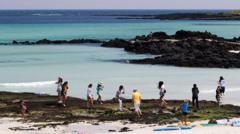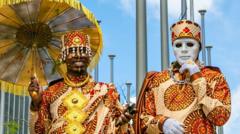Ushuaia, Argentina, known as the “end of the world,” is witnessing an unprecedented influx of tourists headed for Antarctica. With around 90% of all Antarctic cruises departing from this southernmost city, tourists are swarming the area, excited to explore the natural wonders that await them. The summer months have become particularly crowded, with five major cruise ships filling the ports, bringing a wave of passengers who each pay between $15,000 and $18,000 for luxury tours to the icy continent.
The numbers speak volumes: ten years ago, approximately 35,500 travelers embarked on Antarctic adventures from Ushuaia. Last year, that number skyrocketed to about 111,500, and this year’s estimates suggest another 10% increase. Many tourists prefer to extend their visits, opting for short stays in local accommodations, some of which are now listed on platforms like Airbnb, further showcasing the area's appeal.
This tourism growth is a double-edged sword. While it provides significant economic benefits to Ushuaia’s approximately 83,000 residents, the strain on local resources is becoming evident. The sharp rise in demand has contributed to a housing shortage and increased living costs, creating challenges for locals trying to navigate the booming market. The city, tucked between the Andes mountains and the Beagle Channel, is touted for its uniqueness, yet that very isolation adds pressure on its infrastructure.
Julio Lovece, president of the Ushuaia Foundation XXI, highlights the delicate balance of promoting tourism while ensuring it benefits the community. “We sell an aura,” he explains, emphasizing that the city’s allure lies in its distinct location rather than conventional attractions like waterfalls or glaciers. As tourism continues to thrive, the question of sustainability looms large: how long can this “end of the world” remain wild before the very environment that draws tourists starts to suffer from the burden?
The numbers speak volumes: ten years ago, approximately 35,500 travelers embarked on Antarctic adventures from Ushuaia. Last year, that number skyrocketed to about 111,500, and this year’s estimates suggest another 10% increase. Many tourists prefer to extend their visits, opting for short stays in local accommodations, some of which are now listed on platforms like Airbnb, further showcasing the area's appeal.
This tourism growth is a double-edged sword. While it provides significant economic benefits to Ushuaia’s approximately 83,000 residents, the strain on local resources is becoming evident. The sharp rise in demand has contributed to a housing shortage and increased living costs, creating challenges for locals trying to navigate the booming market. The city, tucked between the Andes mountains and the Beagle Channel, is touted for its uniqueness, yet that very isolation adds pressure on its infrastructure.
Julio Lovece, president of the Ushuaia Foundation XXI, highlights the delicate balance of promoting tourism while ensuring it benefits the community. “We sell an aura,” he explains, emphasizing that the city’s allure lies in its distinct location rather than conventional attractions like waterfalls or glaciers. As tourism continues to thrive, the question of sustainability looms large: how long can this “end of the world” remain wild before the very environment that draws tourists starts to suffer from the burden?





















